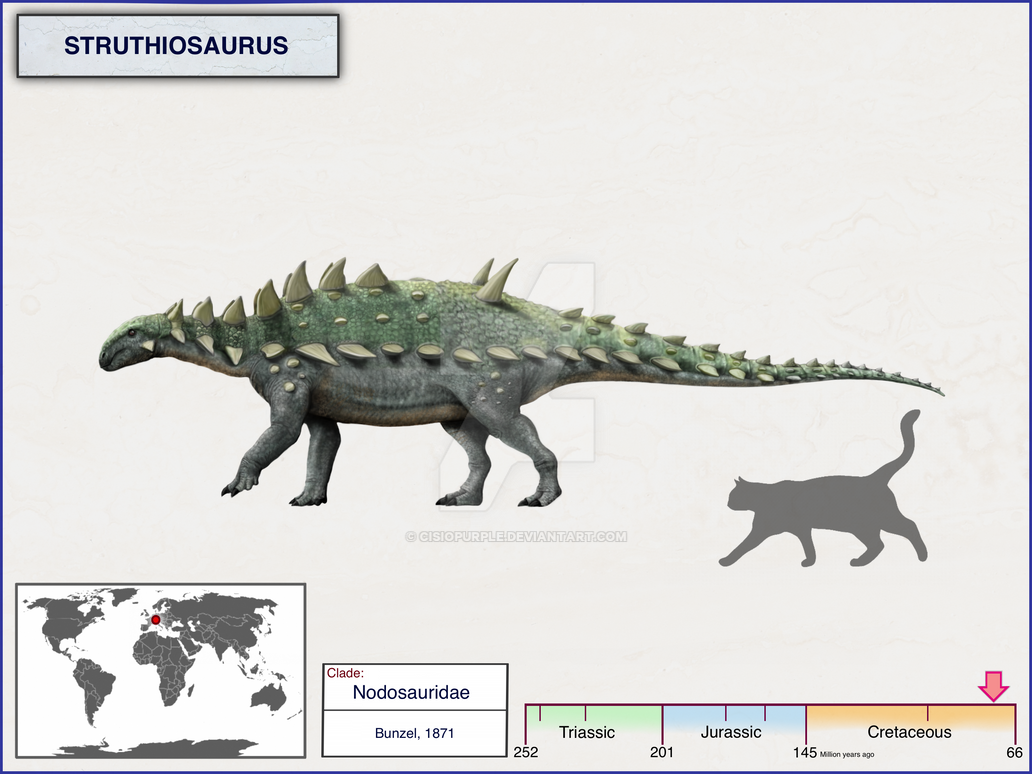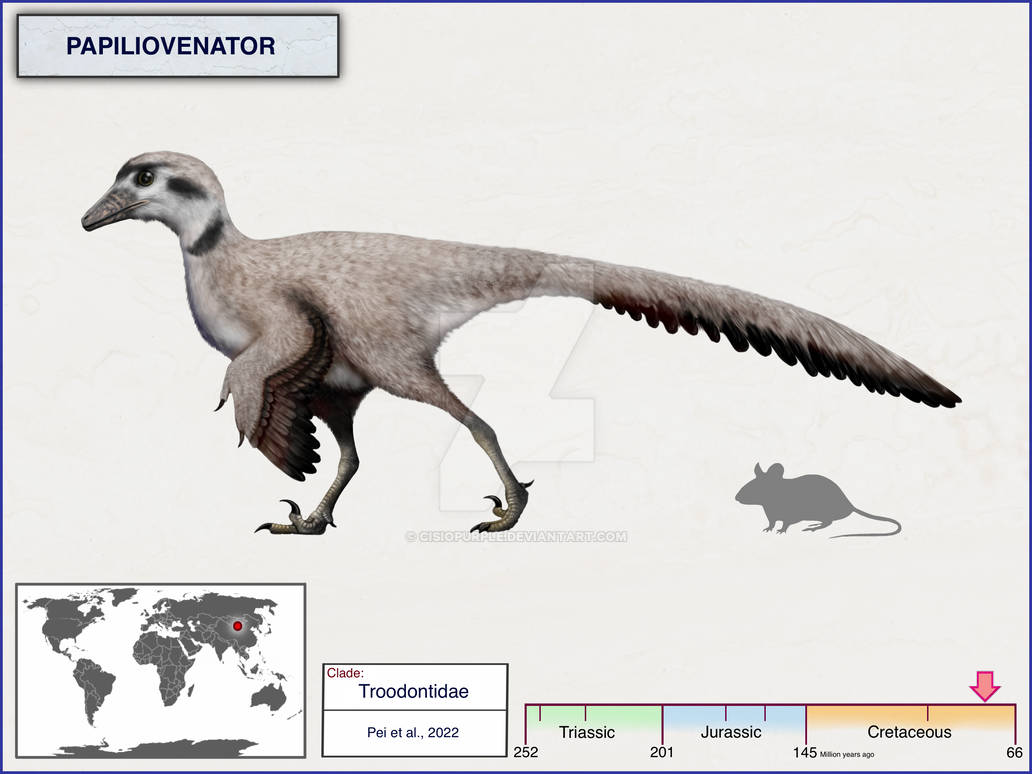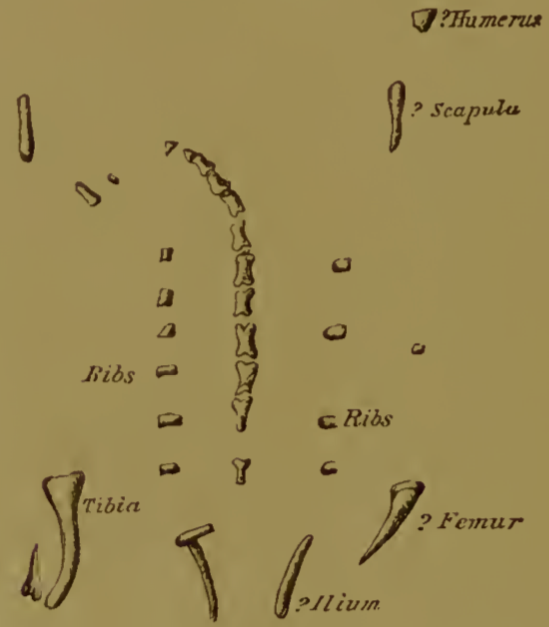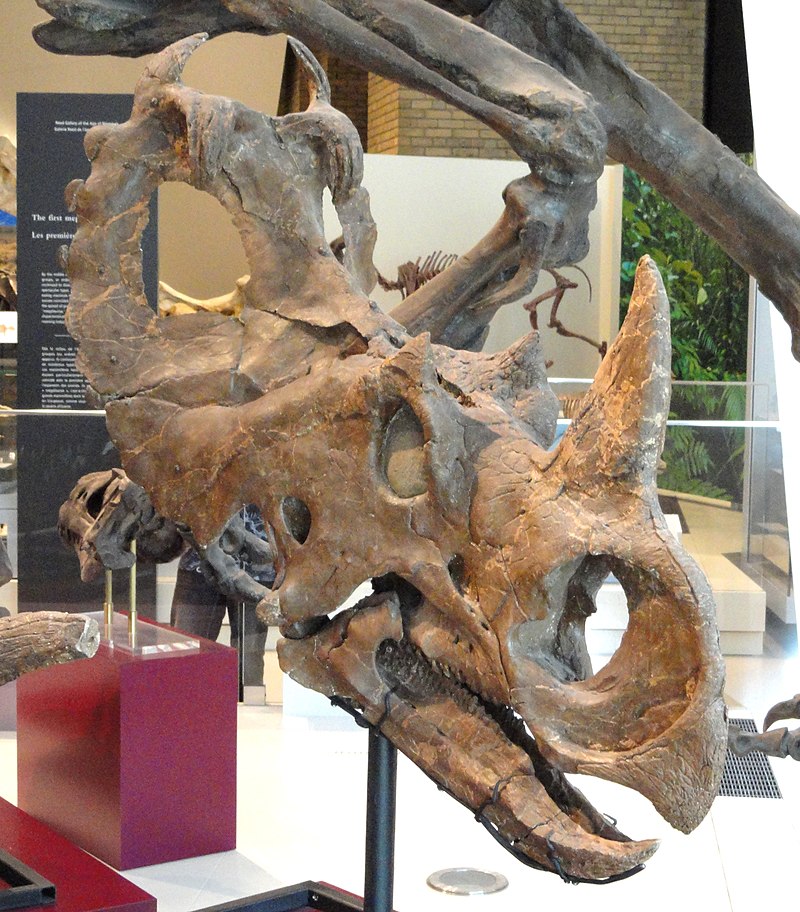|
|
Post by Talira Greycrest on Jan 17, 2024 7:14:59 GMT
Just a friendly reminder about this week's quiz question. You've been asked: Which sauropod's name means "Double beam"? Alamosaurus, Demandasaurus, Paluxysaurus, Vahiny, Diplodocus or Rapetosaurus?Today's dino.... Name: EoplophysisPronunciation: Ee-oh-plo-fy-sisMeaning of name: "Dawn armed form"Species: E. vetustus Size: Full adult size uncertain as the only known fossils belong to a juvenile.Family: StegosauridaeDiet: HerbivoreFirst fossils found: Known only from a single right thigh bone belonging to a juvenile discovered in the Cornbrash Formation of Oxfordshire, southern England. Was originally named as a species of Omosaurus by German palaeontologist, Friedrich von Huene, in 1910, before being renamed as a species of Dacentrurus by British palaeontologist, Peter Malcolm Galton, in 1972. Was then named as a species of Lexovisaurus in 1993. Eventually recognized as a new genus and named Eoplophysis by Roman Ulansky in 2014.Lived: 166 million years ago during the Bathonian stage of the Middle Jurassic in what is now southern England. Eoplophysis thigh bone Eoplophysis thigh bone |
|
Tix Mascot
Tech guru
Italy is my second homeland
Posts: 11,097  Mini-Profile Background: {"image":"http://4.bp.blogspot.com/-X5mhw13BJ7Y/TwKeZ3uM7YI/AAAAAAAABPw/D82go4Ny_8E/s1600/italy-background-8-787281.jpg","color":""}
Mini-Profile Text Color: 0ef8f1
Mini-Profile Name Color: f40d39
Year of Birth: 1961
Nationality: Norwegian
Mini-Profile Background: {"image":"http://4.bp.blogspot.com/-X5mhw13BJ7Y/TwKeZ3uM7YI/AAAAAAAABPw/D82go4Ny_8E/s1600/italy-background-8-787281.jpg","color":""}
Mini-Profile Text Color: 0ef8f1
Mini-Profile Name Color: f40d39
Year of Birth: 1961
Nationality: Norwegian
|
Post by Tix Mascot on Jan 17, 2024 13:37:05 GMT
I was unable to find how it looked like, but one site indicated that it had some strange bulbs on its back that reminds me of oversized onions.
|
|
|
|
Post by Talira Greycrest on Jan 18, 2024 6:49:38 GMT
Name: StruthiosaurusPronunciation: Stru-thee-oh-sore-usMeaning of name: "Ostrich lizard", in reference to the birdlike morphology of the braincase.Species: S. austriacus, S. languedocensis, S. transylvanicusSize: Depending on species, estimated to have measured between 2 and 3 metres long and weighing between 300 and 400kgs.Family: Struthiosaurinae (a subfamily of Nodosauridae)Diet: HerbivoreFirst fossils found: Known from numerous specimens discovered in Romania, Austria, France and Hungary. First discovered by Austrian geologist, Eduard Suess, in northeastern Austria, in 1859. S. austriacus named by Austrian palaeontologist, Emanuel Bunzel, in 1871. S. transylvanicus named in 1915. S. languedocensis named in 2003.Lived: Depending on species, lived between 85 and 66 million years ago from the Santonian stage through to the Maastrichtian stage of the Late Cretaceous in what is now Romania, Austria, France and Hungary.

|
|
Tix Mascot
Tech guru
Italy is my second homeland
Posts: 11,097  Mini-Profile Background: {"image":"http://4.bp.blogspot.com/-X5mhw13BJ7Y/TwKeZ3uM7YI/AAAAAAAABPw/D82go4Ny_8E/s1600/italy-background-8-787281.jpg","color":""}
Mini-Profile Text Color: 0ef8f1
Mini-Profile Name Color: f40d39
Year of Birth: 1961
Nationality: Norwegian
Mini-Profile Background: {"image":"http://4.bp.blogspot.com/-X5mhw13BJ7Y/TwKeZ3uM7YI/AAAAAAAABPw/D82go4Ny_8E/s1600/italy-background-8-787281.jpg","color":""}
Mini-Profile Text Color: 0ef8f1
Mini-Profile Name Color: f40d39
Year of Birth: 1961
Nationality: Norwegian
|
Post by Tix Mascot on Jan 18, 2024 13:32:19 GMT
Not too big, but looks as if it's more than capable of defending itself.
|
|
|
|
Post by Talira Greycrest on Jan 19, 2024 7:20:21 GMT
A final reminder about this week's quiz question before the answer is revealed tomorrow. You've been asked: Which sauropod's name means "Double beam"? Alamosaurus, Demandasaurus, Paluxysaurus, Vahiny, Diplodocus or Rapetosaurus?Today's dino:Name: PapiliovenatorPronunciation: Pah-pe-le-oh-ven-ah-torMeaning of name: "Butterfly hunter", in reference to the butterfly-shaped feature on its first two dorsal vertebrae.Species: P. neimengguensisSize: Full adult size uncertain as the only known fossils belong to a subadult.Family: TroodontidaeDiet: CarnivoreFirst fossils found: Known only from a partial skull and partial skeleton belonging to a subadult, discovered in the Bayan Mandahu Formation of Inner Mongolia, northern China. Named by Rui Pei, Yuying Qin, Aishu Wen, Qi Zhao, Zhe Wang, Zhanmin Liu, Weilesi Guo, Po Liu, Weiming Ye, Lanyun Wang, Zhigang Yin, Ruiming Dai and Xu Xing in 2022.Lived: 83.6 to 72.1 million years ago during the Campanian stage of the Late Cretaceous in what is now Inner Mongolia, northern China.

|
|
Tix Mascot
Tech guru
Italy is my second homeland
Posts: 11,097  Mini-Profile Background: {"image":"http://4.bp.blogspot.com/-X5mhw13BJ7Y/TwKeZ3uM7YI/AAAAAAAABPw/D82go4Ny_8E/s1600/italy-background-8-787281.jpg","color":""}
Mini-Profile Text Color: 0ef8f1
Mini-Profile Name Color: f40d39
Year of Birth: 1961
Nationality: Norwegian
Mini-Profile Background: {"image":"http://4.bp.blogspot.com/-X5mhw13BJ7Y/TwKeZ3uM7YI/AAAAAAAABPw/D82go4Ny_8E/s1600/italy-background-8-787281.jpg","color":""}
Mini-Profile Text Color: 0ef8f1
Mini-Profile Name Color: f40d39
Year of Birth: 1961
Nationality: Norwegian
|
Post by Tix Mascot on Jan 19, 2024 20:50:59 GMT
This gives a new meaning to the expression 'angry bird'.
|
|
darrenvox
Level 8 DP Minister
im good
Posts: 2,194  Mini-Profile Background: {"image":"https://i.ibb.co/kSk7YMg/image.jpg","color":""}
Mini-Profile Text Color: red
Mini-Profile Name Color: red
Year of Birth: april 17 1981
Nationality: canada
Mini-Profile Background: {"image":"https://i.ibb.co/kSk7YMg/image.jpg","color":""}
Mini-Profile Text Color: red
Mini-Profile Name Color: red
Year of Birth: april 17 1981
Nationality: canada
|
Post by darrenvox on Jan 20, 2024 2:11:13 GMT
sure does
|
|
|
|
Post by Talira Greycrest on Jan 20, 2024 5:28:44 GMT
Tix Mascot , LadyPorthos , well done for correctly guessing the answer to this week's quiz question. You were asked: Which sauropod's name means "Double beam"? Alamosaurus, Demandasaurus, Paluxysaurus, Vahiny, Diplodocus or Rapetosaurus?
Answer: Diplodocus. Living in what is now the western and midwestern United States during the Kimmeridgian stage of the Late Jurassic (154 to 152 million years ago), Diplodocus is one of the longest dinosaurs known from a complete skeleton, with a total length of between 24 and 26 metres. The name "Double beam" refers to the double-beamed chevron bones located in the underside of the tail, which were, at the time of discovery, considered unique. The first Diplodocus fossils were discovered by Benjamin F. Mudge and Samuel W. Williston in Colorado in 1877. Currently, there are three species: D. carnegii, D. hallorum and D. longus
|
|
|
|
Post by Talira Greycrest on Jan 20, 2024 6:41:05 GMT
Name: HortalotarsusPronunciation: Hor-tah-low-tar-susMeaning of name: "Tarsus of a young bird"Species: H. skirtopodusSize: Uncertain due to a lack of fossils, but is estimated to have measured around 3 metres.Family: MassospondylidaeDiet: HerbivoreFirst fossils found: Originally known from a partial skeleton discovered in the Clarens Formation of South Africa. However, most of the skeleton was destroyed by a failed attempt to free it from the rock using gunpowder, so the only fossils that exist today are some partial foot and leg bones. Was originally named as a species of Thecodontosaurus by British palaeontologist, Harry Govier Seeley, in 1892, before being renamed Hortalotarsus in 1894.Lived: 199.5 to 192.9 million years ago during the Sinemurian stage of the Early Jurassic in what is now South Africa. Drawing of the original Hortalotarsus fossils. Drawing of the original Hortalotarsus fossils.
|
|
Joey
Service Department   Loyal member, member number 100, contest winner & super-poster
[TI38] Never do today what you can put off till tomorrow.
Loyal member, member number 100, contest winner & super-poster
[TI38] Never do today what you can put off till tomorrow.
Posts: 14,144
Mini-Profile Background: {"image":"http://www.eurogarden.ro/images/galerie/galerie9/1873-flower_garden.jpg"}
Year of Birth: Before dirt
Nationality: Euro-American
|
Post by Joey on Jan 20, 2024 7:24:47 GMT
For the quiz I'll guess Diplodocus.
Nice looking heave bones you have there.
|
|
Tix Mascot
Tech guru
Italy is my second homeland
Posts: 11,097  Mini-Profile Background: {"image":"http://4.bp.blogspot.com/-X5mhw13BJ7Y/TwKeZ3uM7YI/AAAAAAAABPw/D82go4Ny_8E/s1600/italy-background-8-787281.jpg","color":""}
Mini-Profile Text Color: 0ef8f1
Mini-Profile Name Color: f40d39
Year of Birth: 1961
Nationality: Norwegian
Mini-Profile Background: {"image":"http://4.bp.blogspot.com/-X5mhw13BJ7Y/TwKeZ3uM7YI/AAAAAAAABPw/D82go4Ny_8E/s1600/italy-background-8-787281.jpg","color":""}
Mini-Profile Text Color: 0ef8f1
Mini-Profile Name Color: f40d39
Year of Birth: 1961
Nationality: Norwegian
|
Post by Tix Mascot on Jan 20, 2024 11:04:28 GMT
Like a 3-dimensional jigsaw puzzle.
|
|
|
|
Post by Talira Greycrest on Jan 21, 2024 7:28:32 GMT
Name: LinheraptorPronunciation: Lin-he-rap-torMeaning of name: "Linhe thief" or "Linhe hunter", in reference to the district of Inner Mongolia, northern China, where its fossils were discovered.Species: L. exquisitusSize: 1.8 metres long and weighing around 25kgs.Family: Velociraptorinae (a subfamily of Dromaeosauridae)Diet: CarnivoreFirst fossils found: Known only from a single, almost complete skeleton discovered by Jonah N. Choiniere and Michael Pittman in the Wulansuhai Formation of Inner Mongolia, northern China, in 2008. Named by Chinese palaeontologist, Xu Xing, in 2010.Lived: 83.6 to 72.1 million years ago during the Campanian stage of the Late Cretaceous in what is now Inner Mongolia, northern China. Artist's impression of Linheraptor Artist's impression of Linheraptor
New quiz question: Which of the following Australian dinosaurs was the first to be officially named? Australovenator, Leaellynasaura, Rhoetosaurus, Qantassaurus, Minmi or Wintonotitan?
|
|
Tix Mascot
Tech guru
Italy is my second homeland
Posts: 11,097  Mini-Profile Background: {"image":"http://4.bp.blogspot.com/-X5mhw13BJ7Y/TwKeZ3uM7YI/AAAAAAAABPw/D82go4Ny_8E/s1600/italy-background-8-787281.jpg","color":""}
Mini-Profile Text Color: 0ef8f1
Mini-Profile Name Color: f40d39
Year of Birth: 1961
Nationality: Norwegian
Mini-Profile Background: {"image":"http://4.bp.blogspot.com/-X5mhw13BJ7Y/TwKeZ3uM7YI/AAAAAAAABPw/D82go4Ny_8E/s1600/italy-background-8-787281.jpg","color":""}
Mini-Profile Text Color: 0ef8f1
Mini-Profile Name Color: f40d39
Year of Birth: 1961
Nationality: Norwegian
|
Post by Tix Mascot on Jan 21, 2024 13:05:00 GMT
New quiz question: Which of the following Australian dinosaurs was the first to be officially named? Australovenator, Leaellynasaura, Rhoetosaurus, Qantassaurus, Minmi or Wintonotitan? This time, I don't have any clues to help me, so I guess that Australovenator was the first. |
|
LadyPorthos
Service Department   Member of the year 2019, 2020, 2022 and 2023, loyal member, contest winner, quiz-master, super-poster and supreme monster slayer
[TI16] We are the music makers and we are the dreamers of dreams...
Member of the year 2019, 2020, 2022 and 2023, loyal member, contest winner, quiz-master, super-poster and supreme monster slayer
[TI16] We are the music makers and we are the dreamers of dreams...
Posts: 11,362  Mini-Profile Background: {"image":"http://i.imgur.com/nYl1mR0.jpg","color":""}
Mini-Profile Text Color: 000205
Nationality: American
Mini-Profile Background: {"image":"http://i.imgur.com/nYl1mR0.jpg","color":""}
Mini-Profile Text Color: 000205
Nationality: American
|
Post by LadyPorthos on Jan 21, 2024 19:46:42 GMT
New quiz question: Which of the following Australian dinosaurs was the first to be officially named? Australovenator, Leaellynasaura, Rhoetosaurus, Qantassaurus, Minmi or Wintonotitan?I'll guess Australovenator |
|
|
|
Post by Talira Greycrest on Jan 22, 2024 6:53:01 GMT
Name: CentrosaurusPronunciation: Sen-tro-sore-usMeaning of name: "Pointed lizard", in reference to the small spikes lining the edge of the neck shield.Species: C. apertusSize: Measured between 5 and 6 metres long and weighing between 2 and 3 metric tonnes.Family: Centrosaurinae (a subfamily of Ceratopsidae)Diet: HerbivoreFirst fossils found: Known from thousands of individuals of various ages discovered in the Dinosaur Park and Oldman Formations of Alberta, western Canada. First discovered by Canadian palaeontologist, Lawrence Morris Lambe. Named by Mr. Lambe in 1904.Lived: 76.5 to 75.5 million years ago during the Campanian stage of the Late Cretaceous in what is now western Canada.
 Centrosaurus skull on display at the Royal Ontario Museum, Toronto, Ontario, Canada. Centrosaurus skull on display at the Royal Ontario Museum, Toronto, Ontario, Canada.
|
|